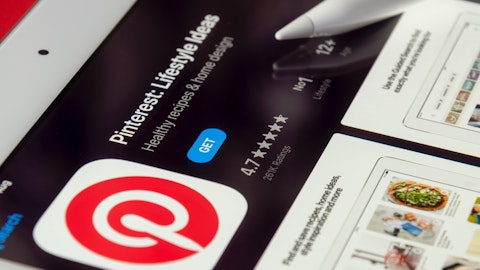Julia Donnelly: Yes. Thanks, Brian, for the question. I’ll take the first part and maybe kick it over to Bill for the second part of your question. So we did see engagement trends continue the same trends that we showed at Investor Day. So we talked about strong engagement growth on the call. We also talked about the increase in ad impressions of 26% being driven by both total impressions growth increasing and ad load increasing. So the same trend of ongoing engagement growth across the basket of metrics that we monitor and talked about on Investor Day, continues to hold for Q3 specifically. And now Bill for the second part.
William Ready: Yeah. So this is actually a really great area, Brian, in terms of what’s required to implement our lower funnel solutions here and how that’s going. So Mobile Deep Links, which had has had really great results and been, 235% lift in conversion rates, which is really experienced taking the user from Pinterest, straight into the product and buying experience in a retailer’s mobile app. But there’s a lot of retail that may not have users on their mobile app. And so with Direct Link, we’re now taking that a similar experience that will drop the user straight into a product and/or purchase experience with the retailer’s website or mobile website, and we’re deploying that very rapidly. And we’re actually able to deploy that even faster than mobile deep links.
So we now have approximately 60% of our revenue of our lower funnel revenue has been migrated to direct links. And so the value creation of that has really been tremendous. We talked about 88% higher outbound click-through rate and 39% decrease in cost per outbound click. That’s just really phenomenal value creation for the advertiser. And so advertisers have been seeing that. The other thing to note is that we are still in the beginning of capturing the value from that because we started rolling that out sort of in the back half of Q3. And I shared some comments as to how we’re continuing to roll that out into Q4 and even into Q1, and we have our measurement progress that lets the advertisers measure all that goodness that they’re seeing. So the shift of budgets that can result from that, I think while we have really accelerated the value creation for the advertiser, and they’re really pleased with what they’re seeing.
I’d say we’re still early on in capturing the value from that. So I think there’s a lot of tailwind to that deployment as we continue forward into Q4 and in the next year.
Operator: Thank you. Our next question is from Mark Mahaney with Evercore ISI. Please proceed.
Mark Mahaney: Thanks. Two questions, please. The growth in MAUs was most pronounced in ROW — the rest of the world regions. Any particular markets there or countries you would call out there? Is there something that suggests that, that growth is there’s a new growth element in ROW? And then secondly, I think two other companies have talked about seeing a little bit of a pause in ad spend due to geopolitical factors earlier in the quarter? Are you seeing anything like that? Thank you.
William Ready: So I’ll take the second part of your question first, Mark, and thanks for the questions. So before I get to that, actually, I want to just take a moment to acknowledge the tragic situation on the ground in Israel and Gaza. While Pinterest doesn’t have employees there our thoughts are definitely with all those that are affected truly beyond words, the situation there. So with regard to the impact of the geopolitical situation, advertisers do react to major geopolitical situations. But spending on our platform has been relatively resilient so far in the quarter. When the Middle East conflict broke out, some brand advertisers did temporarily pause spend, and this resulted in a minor short-term impact. But we’ve since seen those advertisers largely return.
And if the geopolitical environment were to get materially worse, we’d expect that brand advertising would be more at risk and performance ads would be more resilient. So platform skewed more to brand would be more impacted than we would be given the progress we’ve made in the lower funnel. But if advertisers pull back spend in a more meaningful way than what we’ve seen so far, we’re not going to be immune to that. But taking into account everything we know today and what we’ve seen so far, we feel good about our ability to execute in the quarter, bolstered by our recent product improvements at the lower end of the funnel, which is factored into our Q4 guidance. And then on the math side, it continues to be a story of mature markets where it’s a story of deepening engagement in mature markets.
And then broad-based strength, as you look to rest of world, we’re getting more and more relevant results. A lot of these things we’re talking about in great improvement and relevancy using next-gen AI technology. These are things that are having a global impact in mature markets where we’ve seen a lot of the users that we need to see that manifest as deepening engagement per user. As you look to rest of world, you see even more mile growth happening in those markets.
Operator: Thank you. Our next question is from Doug Anmuth from JPMorgan. Please proceed.
Douglas Anmuth: Thanks for taking the questions. At the Analyst Day, you talked about launching a fully automated ad tool in 2024, similar to some of the other large platforms. I was just hoping you could provide an update on that? Perhaps any commentary just around how the build progress is going there? That’s all. Thank you.




